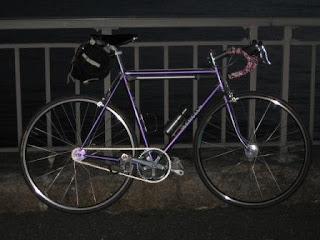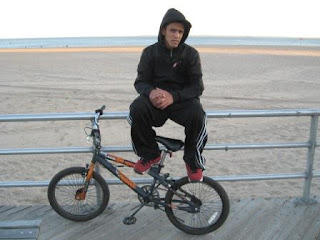If there is a cycling Nirvana, would all of the ugly places be airbrushed out of it?
A fact of life, at least in this part of the world, is that to ride to a beautiful place, you sometimes have to pass through some blighted spots.
Here is one I sometimes pass on my way to or from the Rockaways (as I did today) or Point Lookout:
In any industrialized country, you can find thousands (or even more) places like this. It's hard in the shadow, literally, of the MTA's Rockaway trestle, on which the A train rumbles and clatters. Yes, that A train: Duke Ellington's A train. (I chose the link I included because on it, Ella Fitzgerald sings. The slide show, ironically, shows pretty much every kind of train except for the titular one. It doesn't even show a NYC subway train!) This is nearly the opposite end of the line, literally and figuratively, of the subway route Ellington made famous. Stay on the train for about an hour and a half and you'll be in Harlem, just a couple of stops from the line's terminus at the very northern end of Manhattan.
On the other side of that trestle are bungalows in various states of disrepair and the beach.
That beach is one you've heard of if you have even the most basic knowledge of 70's popular music: It's the Rockaway Beach of the Ramones' eponymous song. It sounds like a Beach Boys song as Brian Wilson might have played it while in withdrawal from something.
So, why should you care about any of this if you're a cyclist?
Well, not so long ago, the site in the photo was a rather important part of American cycling: It was the home of the Chain Bicycle Corporation.
Now, if we'd had bicycle companies called Sprocket, Derailleur, Crank, Wheel or Frame, American cycling history might have been different. How, I don't know. But I digress.
You've probably seen, and you may have ridden,a bike that CBC made or sold. CBC was the parent company of Ross bicycles. Those bikes were sold in the first two bike shops in which I worked. While I was working in my first shop, Ross bikes were at the lower end of the market: sturdy bikes, mainly for kids, but also a few utility bikes. They didn't have the cachet of Schwinn although many of their bikes were similar, and were aimed at similar audiences.
If you're of my generation, you might remember a show called "Wonderama." It was an extravaganza, marathon or ordeal, depending on your point of view, that aired all day Sunday, or so it seemed. The show featured, among other things, games and competitions involving kids from the studio audience. Ross Apollo bicycles were often given as prizes.
Anyway, after the vogue for "chopper" or "muscle" bikes passed, Ross started to aim for the more dedicated (and affluent) adult cyclists. So, by the time I was working in my second shop, Ross was offering its "Signature" series of bicycles and frames, which seemed to be designed to compete with Schwinn's Paramount line. The very best signature bikes were actually very nice. They were built by Tom Kellogg, considered one of the best American custom builders of that time. Most of those frames were constructed from Reynolds 531 tubing, though he occasionally made frames from Columbus and Ishiwata tubings.
I actually had one of those frames for a time. It had been built as a kind of sport-touring frame. But it, like the other "signature" bikes, was even more expensive than other premium bikes from top builders. And people who were buying high-end touring bikes usually wanted cantilever brakes. The frame did not have bosses for them. So the owner of the shop sent the frame to Ross to have the bosses brazed on. By that time, Tom Kellogg was no longer working for Ross.
The frame had been made for 700C wheels. Ross, in its infinite wisdom, brazed on bosses for 26 inch wheels. So it was even less salable than it had been; as a result, the shop's owner was willing to let me take it as pay for a couple of days' work, if I recall correctly. I proceeded to build it up into a sort of cross between an audax/randonneuring bike and a mountain bike with slick tires.
I rode that bike whenever I wasn't riding my racing bike. It was a lot of fun: I took it on trails, on the streets and in lots of other places. Unfortunately, the fun didn't last very long: About two years after I got it, I crashed it into the back of a taxi by the backside of Madison Square Garden/Penn Station.
By then, most, if not all, Rosses were being made in Taiwan. I'm not sure whether they're still being made at all. And, these days, it seems that anyone who's cycling through the Rockaways doesn't live there.
A fact of life, at least in this part of the world, is that to ride to a beautiful place, you sometimes have to pass through some blighted spots.
Here is one I sometimes pass on my way to or from the Rockaways (as I did today) or Point Lookout:
On the other side of that trestle are bungalows in various states of disrepair and the beach.
That beach is one you've heard of if you have even the most basic knowledge of 70's popular music: It's the Rockaway Beach of the Ramones' eponymous song. It sounds like a Beach Boys song as Brian Wilson might have played it while in withdrawal from something.
So, why should you care about any of this if you're a cyclist?
Well, not so long ago, the site in the photo was a rather important part of American cycling: It was the home of the Chain Bicycle Corporation.
Now, if we'd had bicycle companies called Sprocket, Derailleur, Crank, Wheel or Frame, American cycling history might have been different. How, I don't know. But I digress.
You've probably seen, and you may have ridden,a bike that CBC made or sold. CBC was the parent company of Ross bicycles. Those bikes were sold in the first two bike shops in which I worked. While I was working in my first shop, Ross bikes were at the lower end of the market: sturdy bikes, mainly for kids, but also a few utility bikes. They didn't have the cachet of Schwinn although many of their bikes were similar, and were aimed at similar audiences.
If you're of my generation, you might remember a show called "Wonderama." It was an extravaganza, marathon or ordeal, depending on your point of view, that aired all day Sunday, or so it seemed. The show featured, among other things, games and competitions involving kids from the studio audience. Ross Apollo bicycles were often given as prizes.
Anyway, after the vogue for "chopper" or "muscle" bikes passed, Ross started to aim for the more dedicated (and affluent) adult cyclists. So, by the time I was working in my second shop, Ross was offering its "Signature" series of bicycles and frames, which seemed to be designed to compete with Schwinn's Paramount line. The very best signature bikes were actually very nice. They were built by Tom Kellogg, considered one of the best American custom builders of that time. Most of those frames were constructed from Reynolds 531 tubing, though he occasionally made frames from Columbus and Ishiwata tubings.
I actually had one of those frames for a time. It had been built as a kind of sport-touring frame. But it, like the other "signature" bikes, was even more expensive than other premium bikes from top builders. And people who were buying high-end touring bikes usually wanted cantilever brakes. The frame did not have bosses for them. So the owner of the shop sent the frame to Ross to have the bosses brazed on. By that time, Tom Kellogg was no longer working for Ross.
The frame had been made for 700C wheels. Ross, in its infinite wisdom, brazed on bosses for 26 inch wheels. So it was even less salable than it had been; as a result, the shop's owner was willing to let me take it as pay for a couple of days' work, if I recall correctly. I proceeded to build it up into a sort of cross between an audax/randonneuring bike and a mountain bike with slick tires.
I rode that bike whenever I wasn't riding my racing bike. It was a lot of fun: I took it on trails, on the streets and in lots of other places. Unfortunately, the fun didn't last very long: About two years after I got it, I crashed it into the back of a taxi by the backside of Madison Square Garden/Penn Station.
By then, most, if not all, Rosses were being made in Taiwan. I'm not sure whether they're still being made at all. And, these days, it seems that anyone who's cycling through the Rockaways doesn't live there.
















